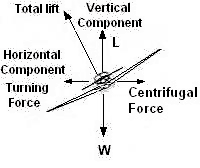How Does an Aircraft Turn?

During steady straight and level flight, the total lift produced equals the aircraft’s weight and a state of balance exists between the lift and weight forces. However, in order to produce a steady coordinated turn at constant altitude, a force must be present which acts towards the centre of the turn. This force is produced by banking the aircraft and tilting the lift force, effectively producing two components of lift at right angles to each other: one acting into the direction of the turn and supplying a turning force, with the other acting upwards to support the aircraft’s weight.
It is often convenient to refer to a centrifugal force rather than speak of the centripetal acceleration associated with curved motion. This centrifugal force is an apparent force, directed outward from the centre, the curved motion appearing to balance the forces producing the centripetal acceleration. By banking the aircraft and tilting the lift line, the amount of lift which was balancing the weight, is decreased. Angle of attack or airspeed will have to be increased to extend the lift line.
In practice, the simplest method is to increase the angle of attack to achieve the required increase in lift so that constant altitude is maintained. Since increasing the angle of attack will also increase the induced drag, additional power will have to be used if airspeed is to be maintained.
For moderate angles of bank, the small loss of airspeed from the slight increased induced drag is acceptable, and power need not be increased, but at steeper bank angles, the lift line is further inclined and significantly larger angles of attack are required with corresponding larger increases in drag. This must be overcome by increasing power, preventing loss of airspeed and height.
|